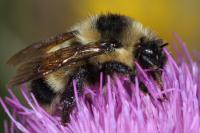
This image shows a Cockerell’s Bumblebee. A team of scientists from the University of California, Riverside recently rediscovered the rarest species of bumblebee in the United States, last seen in 1956, living in the White Mountains of south-central New Mexico.
Known as "Cockerell's Bumblebee," the bee was originally described in 1913 from six specimens collected along the Rio Ruidoso, with another 16 specimens collected near the town of Cloudcroft, and one more from Ruidoso, the most recent being in 1956. No other specimens had been recorded until three more were collected on weeds along a highway north of Cloudcroft on Aug. 31, 2011.
"Most bumblebees in the U.S. are known from dozens to thousands of specimens, but not this species," said Douglas Yanega, senior museum scientist at UC Riverside. "The area it occurs in is infrequently visited by entomologists, and the species has long been ignored because it was thought that it was not actually a genuine species, but only a regional color variant of another well-known species."
Yanega pointed out that there are nearly 50 species of native U.S. bumblebees, including a few on the verge of extinction, such as the species known as "Franklin's Bumblebee," which has been seen only once since 2003. That species, as rare as it is, is known from a distribution covering some 13,000 square miles, whereas Cockerell's Bumblebee is known from an area of less than 300 square miles, giving it the most limited range of any bumblebee species in the world.
"There is much concern lately about declines in our native bumblebee species, and as we now have tools at our disposal to assess their genetic makeup, these new specimens give fairly conclusive evidence that Cockerell's Bumblebee is a genuine species," he said. "With appropriate comparative research, we hope to be able to determine which other species is its closest living relative. Given that this bee occurs in an area that's largely composed of National Forest and Apache tribal land, it's unlikely to be under serious threat of habitat loss at the moment. Since its biology is completely unknown, however, it nevertheless may require some more formal assessment in the future."
Yanega went on to point out that it is not especially surprising for an insect species to be rediscovered after decades, when people might otherwise imagine that it may have gone extinct.
"When an insect species is very rare, or highly localized, it can fairly easily escape detection for very long periods of time," he said. "There are many precedents – some of them very recently in the news, in fact – of insects that have been unseen for anywhere from 70 to more than 100 years, suddenly turning up again when someone either got lucky enough, or persistent enough, to cross paths with them again. It is much harder to give conclusive evidence that an insect species has gone extinct than for something like a bird or mammal or plant."
UCR entomologists rediscover many such "lost" insect species and discover entirely new species on a regular basis, at the rate of several dozen species every year, primarily in groups such as bees, wasps, beetles, and plant bugs. According to recent estimates, approximately 8 million species are in existence, the vast majority being insects of which only about 1 million have been described.
"It should come as no surprise that we discover so many new species of insects so easily," Yanega said. "But the pace of species discovery and description is incredibly slow because there are so few insect taxonomists relative to the number of undescribed insects. Moreover, the work is painstaking, time-consuming, and not very glamorous, at least in the public's perception, when compared to studying things like dinosaurs."
As for plans regarding additional work with Cockerell's Bumblebee, Yanega said that the recent expedition, carried out together with UCR scientists Keve Ribardo and Greg Ballmer, was funded in part by the Friends of the Entomology Research Museum, a non-profit organization supporting UCR's Entomology Research Museum, but that nothing further was yet planned. The DNA sequencing was also carried out at UCR, as part of a larger study on wasp and bee relationships.
"The first step is to come to a firm conclusion regarding the status of this bee as a species," he said. "The second step is spreading the word to the scientific community that this bee deserves some attention, as it has been completely overlooked. Here at UCR we may or may not be involved beyond that point, in gathering data on the distribution and biology of this species, but at the very least our discovery can get the proverbial ball rolling." Source : University of California - Riverside
 Print Article
Print Article Mail to a Friend
Mail to a Friend
